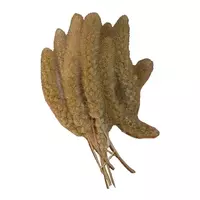Mogar

Mogar or Italian bristle is an annual cultivated plant from the family Cereal or Myatliky, belonging to the genus Bristle. The food and feed culture of the mogar has many qualities in common with ordinary millet, while the plant itself is also known by another name - gomi. Despite the fact that it is mainly customary to cultivate mogar for hay, as green feed and silage, it is sometimes cultivated as a cereal crop.
The mogar grows in rather dense bushes, while forming a closed grass. Well-leafed, erect stems of the mogar with a height reach from 50 to 150 centimeters. The root system of this plant is characterized as urate.
The inflorescence of the mogar is a spike-shaped panicle, the length of which is 20-25 centimeters with a width of about
4. Adjacent to the base of the mogar spikelets are filamentous bristles, colored green, yellowish or dark purple, giving the panicle a shaggy appearance.
Valuable for the agricultural sphere, mogar grains are slightly smaller than millet, while they differ in a more elongated shape. They are less shiny and coloured in shades of yellow to reddish.
In the natural environment, that is, in the wild, this plant is common in Asian countries. Cultured species of mogar grow in countries with temperate and subtropical climates, where they are grown as a feed and food (grain) plant. In the countries of the former USSR, mogar was cultivated for feed, as a rule, in Western Siberia, the North Caucasus, Kazakhstan and the Volga region.
It is noteworthy that in ecological terms, the plant is usually divided into two groups: in fact, the mogar or mogar is mountainous, which is characterized by drought resistance, bushiness and greater precocity, as well as the valley-powdered mogar (kunak), which is characterized by such features as highness, coarseness and less bushiness.
Most often, this plant is cultivated in the fields, from where it is often spread as a weed. You can meet the mogar among the crops of other crops, in settlements and on the sides of the roads. Certain varieties of mogar can be used as an ornamental plant, due to the attractive species of dense panicles, which perfectly complement fresh and dry bouquets or act as an addition to other plantings on a rocky slide.
Basically, mogara grain is used as a feed, but its role in obtaining food grains that are highly nutritious is important. In addition to fodder, mogar is cultivated for food purposes - subsequently it is widely used in the alcohol industry as a raw material.
Mogara 342 kKal
Energy value of mogar (Ratio of proteins, fats, carbohydrates - ju):
Proteins: 11.5 g (~ 46 kCal)
Fats: 3.3 g (~ 30 kCal)
Carbohydrates: 66.5g (~ 266kCal)
Energy ratio (b | y): 13% | 9% | 78%
 Español
Español Français
Français Português
Português Русский
Русский 简体中文
简体中文 繁體中文
繁體中文 日本語
日本語 한국어
한국어 العربية
العربية Türkçe
Türkçe Қазақ
Қазақ Deutsch
Deutsch Italiano
Italiano Українська
Українська
